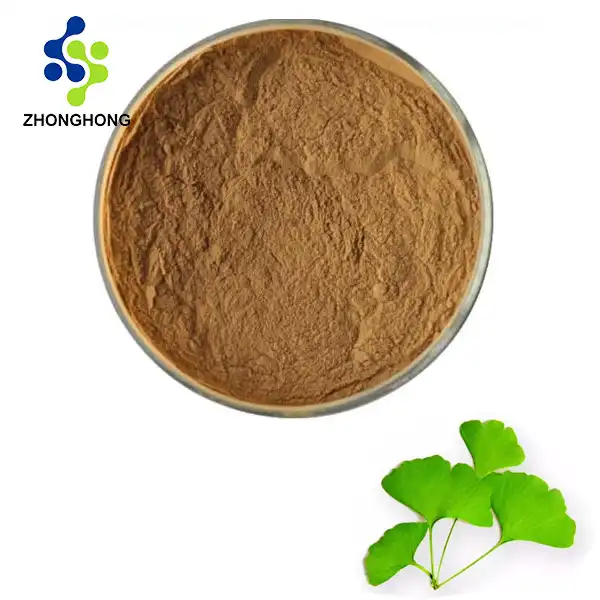English synonyms 24/6 GINKGO BILOBA EXTRACT 24/6; Ginkgo biloba leaves tea bag cut; Ginkgo biloba Ext. Ginkgolic acid max 5ppm; Ginkgo biloba Extract 24/6 5ppm (HPLC); GinkgoBilobaExtract26/6WaterSoluble; GINKGOBILOBAEXTRAKT; GINKGOBILOBA, STANDARDIZEDEXTRACT, POWDER; GINKGO BILOBA LEAF EXTRACT
CAS No. 90045-36-6
EINECS No. 289-896-4
Purity: 99%
HPLC
Packaging information: 1KG; 25KG
Remarks: Pharmaceutical grade
Stock: >100kg
1. Ginkgo biloba L Extract: The Gold Standard in Botanical Solutions by Shaanxi Zhonghong Investment Technology
Introduction
Shaanxi Zhonghong Investment Technology Co., Ltd. is a trailblazing high-tech enterprise specializing in advanced extraction, purification, and global distribution of plant-derived bioactive compounds. Renowned for its expertise in chemistry, materials, and life sciences, the company produces Ginkgo biloba L Extract—a premium ingredient sourced from the ancient Ginkgo biloba tree. Leveraging cutting-edge technology and sustainable practices, this extract is trusted by pharmaceutical, nutraceutical, and cosmetic industries worldwide for its unmatched purity and efficacy.
2. Innovation-Driven Excellence & Global Leadership
Scientific Prowess
Academic Synergy: Collaborates with 5 elite universities to pioneer breakthroughs in botanical research.
Proprietary Innovations: 20+ patents and an exclusive global compound library ensure superior product quality.
Advanced Infrastructure: Employs HPLC, NMR, and CO2 supercritical extraction systems, achieving 20% higher purity than industry standards.
Global Network
Supplies tailored botanical solutions to pharmaceutical giants, research institutions, and wellness brands across 30+ countries in Asia, Europe, and the Americas.
3. Ginkgo biloba L Extract: Product Specifications & Benefits
Source & Extraction
Origin: Sustainably harvested Ginkgo biloba L leaves from eco-certified farms with optimal growing conditions.
Extraction Method: CO2 supercritical fluid extraction (SFE) retains bioactive flavonoids (24%) and terpene lactones (6%).
Chemical Profile
Key Compounds: Flavonoids (quercetin, kaempferol), terpene lactones (ginkgolides A/B/C, bilobalide).
Purity: Customizable from 10% to 50% flavonoids or terpene lactones.
Health & Wellness Benefits
Cognitive Boost: Enhances memory, focus, and mental clarity by improving cerebral blood flow.
Antioxidant Shield: Neutralizes free radicals, reducing oxidative stress and chronic inflammation.
Cardiovascular Support: Promotes healthy circulation and vascular function.
Skin Vitality: Protects against UV damage and stimulates collagen production for youthful skin.
Usage Guidelines
Applications: Dietary supplements, pharmaceuticals (cognitive enhancers), cosmetics (anti-aging formulations), and functional foods.
Dosage: 60–240 mg/day standardized extract (consult a healthcare professional for personalized advice).
Precautions: Avoid concurrent use with blood thinners; unsuitable for pregnant/nursing women or individuals with bleeding disorders.
4. Uncompromising Quality Assurance
| Parameter | Standard | Testing Method |
|---|---|---|
| Pesticide Residues | ≤0.01 ppm (EU/EPA compliant) | GC-MS |
| Heavy Metals | Pb ≤1 ppm, As ≤0.5 ppm, Cd ≤0.2 ppm | ICP-MS |
| Microbial Limits | Total plate count ≤1000 CFU/g | ISO 4833-1:2013 |
| Ginkgolic Acids | ≤5 ppm (ICH Q3D compliant) | HPLC-UV |
5. Diverse Applications Across Industries
Pharmaceuticals: Core component in dementia therapies, anti-anxiety medications, and vasodilators.
Nutraceuticals: Featured in brain health supplements and anti-aging capsules.
Cosmetics: Integrated into serums and creams for UV protection and skin elasticity.
Functional Foods: Enhances mental performance in energy bars and beverages.
6. Sustainable Practices & Certifications
Eco-Conscious Production: Zero-waste extraction processes compliant with ISO 14001.
Certifications: ISO 9001, Halal, Kosher, USDA Organic, and REACH.
Tailored Solutions: Adjustable concentrations, bulk purchasing, and private labeling options.
7. Packaging, Logistics & Customer Support
Packaging: Light-resistant, vacuum-sealed bags (1 kg to 25 kg) or drums for optimal preservation.
Shipping: Global delivery via DHL/FedEx with temperature-controlled logistics.
Samples: Complimentary samples provided for quality assurance.
8. Client Success Stories
“Shaanxi Zhonghong’s Ginkgo biloba L Extract has revolutionized our cognitive health formulations with its exceptional purity and reliability.” – A Top-Tier European Nutraceutical Company
9. FAQs
Q1: Is this extract non-GMO and allergen-free?
Yes, it is non-GMO, gluten-free, and free from major allergens.
Q2: What is the shelf life?
24 months when stored in a cool, dry environment (15–25°C).
Q3: Do you provide regulatory documentation?
Yes, each shipment includes a Certificate of Analysis (COA), MSDS, and export certifications.
10. Why Partner with Shaanxi Zhonghong?
Shaanxi Zhonghong Investment Technology merges cutting-edge extraction technology, rigorous quality protocols, and eco-friendly practices to deliver Ginkgo biloba L Extract that exceeds global benchmarks. Trusted by industry leaders, this extract empowers businesses to innovate with confidence, offering science-backed solutions for health-conscious markets.
References:
European Pharmacopoeia (Ph. Eur.)
FDA Dietary Supplement Regulations
Journal of Clinical Pharmacology (Wiley).
YOU MAY LIKE
_1728976869676.webp)







